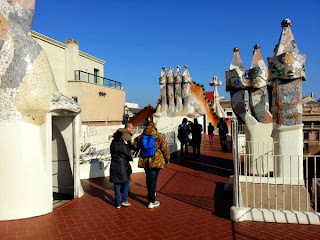I chose to visit two of his more popular sites - along with dozens of other tourists mind you.
The Casa Batilo ... a five storied apartment building in the centre of the city ... This is one of Gaudí's largest and most striking residential works. Commissioned by Josep Batlló i Casanovas to renovate an existing building erected in 1875 by Emili Sala Cortés, Gaudí focused on the facade, the main floor, the patio and the roof, and built an additional floor for the staff.

The facade is of Montjuïc sandstone cut to create
warped surfaces, the columns are bone-shaped with vegetable decoration. Gaudí
kept the rectangular shape of the old building's balconies—with iron railings
in the shape of masks — giving the rest of the facade an ascending undulating
form. He also faced the facade with ceramic fragments of various colours ,
which Gaudí obtained from the waste material of the Pelegrí glass works.
Four of the five floors are occupied today – with the first floor, roof and back courtyard open to hundreds of tourists 7 days all year round !!!
The
interior courtyard is roofed by a skylight supported by an iron structure in
the shape of a double T, which rests on a series of catenary aches.
It is on the roof top that most of the action takes place ...The helicoidal chimneys are a notable feature of the roof, topped with conical caps, covered in clear glass in the centre and ceramics at the top, and surmounted by clear glass balls filled with sand of different colours. The facade culminates in catenary vaults covered with two layers of brick and faced with glazed ceramic tiles in the form of scales (in shades of yellow, green and blue), which resemble a dragon's back; on the left side is a cylindrical turret with anagrams of Jesus, Mary and Joseph, and with Gaudí's four-armed cross.
The Park Guell ... is Gaudí's other famous project (1900–1914) and was commissioned by Eusebi Güell. It was
intended to be a residential estate in the style of an English garden city.
The
project was unsuccessful: of the 60 plots into which the site was divided only
one was sold. Despite this, the park entrances and service areas were built,
displaying Gaudí's genius and putting into practice many of his innovative
structural solutions.
The Park Güell is situated in Barcelona's Càrmel
district, a rugged area, with steep slopes that Gaudí negotiated with a system
of viaducts integrated into the terrain. The main entrance to the park has a
building on each side, intended as a porter's lodge and an office, and the site
is surrounded by a stone and glazed-ceramic wall.
After passing through the gate, steps lead to higher
levels, decorated with sculpted fountains, notably the dragon fountain, which
has become a symbol of the park and one of Gaudí's most recognised emblems.
These steps lead to the Hypostyle Hall, which was to have been the residents'
market, constructed with large Doric columns.
Above this chamber is a large plaza in the form of a
Greek theatre, with the famous undulating bench covered in broken ceramics.
The
park's show home, the work of Francesc Berenguer, was Gaudí's residence from
1906 to 1926, and currently houses a portion of the Casa-Museu Gaudi.
Roadways around the park
to service the intended houses were designed by Gaudí as structures jutting out
from the steep hillside or running on viaducts, with separate footpaths in
arcades formed under these structures. This minimized the intrusion of the
roads, and Gaudí designed them using local stone in a way that integrates them
closely into the landscape. His structures echo natural forms, with columns
like tree trunks supporting branching vaulting under the roadway.
Pidgeons enjoying the Dragon Fountain
Gaudi's other admired apartment building in Barcelona - Casa Mila
A sad
postscript … On 7 June 1926, Gaudí
was taking his daily walk to church for his habitual prayer and confession.
While walking along the street, he was struck by a passing tram and lost
consciousness. Assumed to be a beggar because of his lack of identity documents
and shabby clothing, the unconscious Gaudí did not receive immediate aid.
Eventually a police officer transported him in a taxi to Hospital, where he
received rudimentary care.
By the time that he was recognised on the following day, Gaudí's
condition had deteriorated too severely to benefit from additional treatment.
Gaudí died on 10 June 1926 at the age of 73 and was buried two days later in the crypt of the Sagrada Familia ...






































No comments:
Post a Comment
Note: Only a member of this blog may post a comment.